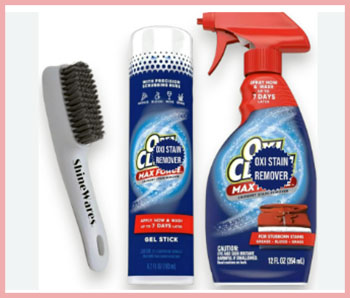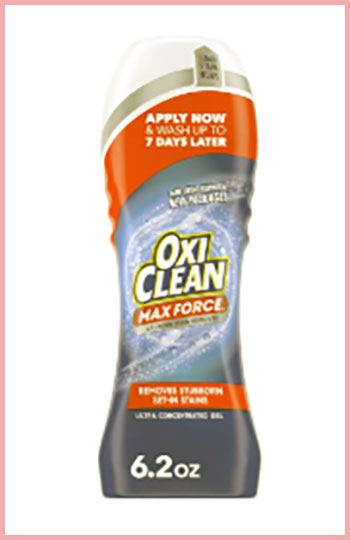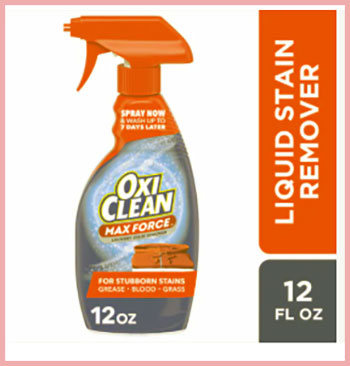
I’m no stranger to stains—coffee splashes, grass smudges, and the occasional mystery mark on my favorite shirt. As someone who’s battled laundry disasters for years, I’ve turned to OxiClean’s gel stick and spray to save my clothes.
In this article, I’ll compare these two stain-fighting powerhouses, sharing my hands-on experience, pros, cons, and which one I reach for most. Whether you’re tackling fresh spills or set-in stains, I’ll help you decide which OxiClean product fits your laundry routine best.
Comparison Table: OxiClean Gel Stick vs. Spray
| Feature | OxiClean Max Force Gel Stick | OxiClean Max Force Spray |
| Application Method | Direct rub-on with nubs | Spray from bottle |
| Formula | Concentrated gel | Liquid spray |
| Best for | Targeted, tough stains | Larger areas, fresh stains |
| Portability | Compact, travel-friendly | Bulkier, less portable |
| Pretreat Time | 5–30 minutes, up to 7 days | 5–10 minutes |
| Stain Types | Grease, oil, blood, grass | Food, wine, oil, dirt |
| Ease of Use | Moderate (requires rubbing) | Easy (quick spray) |
| Price (Approx.) | $5–$7 for 6.2 oz | $6–$8 for 12 oz |
| Residue Risk | Low, but can ooze | Minimal, dries fast |
Why I’m Comparing OxiClean Gel Stick and Spray
Laundry is my weekly nemesis. Between my kids’ muddy soccer uniforms and my own clumsy coffee spills, I’ve spent countless hours testing stain removers. OxiClean’s Max Force line stands out for its oxygen-based cleaning power, but choosing between the gel stick and spray isn’t always straightforward.
Both promise to tackle tough stains, but their application, effectiveness, and convenience differ. I’ve used both extensively, from pretreating set-in grease to zapping fresh wine stains, and I’m sharing what I’ve learned to help you pick the right one.
OxiClean Gel Stick: My Experience
The OxiClean Max Force Gel Stick is a compact, deodorant-like tube with a thick, blue-tinted gel. Its standout feature? Those “stain-grabbing nubs” on the applicator, designed to work the gel deep into fabric fibers.
I first tried it on a grease stain from my husband’s work shirt, which had been sitting for hours. Skeptical, I rubbed the gel in, let it sit for 15 minutes, and tossed it in the wash. To my shock, the stain vanished.
Key Features of the Gel Stick
- Concentrated Formula: Packed with surfactants and enzymes, it targets grease, oil, blood, and grass.
- Direct Application: The nubs let you scrub the gel into stains for precise treatment.
- Flexible Pretreat Time: You can apply it and wash up to a week later.
- Portability: At 6.2 ounces, it’s easy to toss in a bag or keep in a drawer.
Pros of the Gel Stick

- Precision Targeting: I love how I can focus on small, stubborn stains without wasting product. The nubs help me work the gel into tight spots, like shirt collars or cuffs.
- Long Pretreat Option: Life gets busy, so being able to treat a stain and wash it days later is a game-changer.
- Effective on Set-In Stains: It’s saved clothes I thought were goners, like a white tee with a week-old ketchup stain.
- Travel-Friendly: I keep one in my car for emergencies, like when my kid spills juice on a road trip.
Cons of the Gel Stick
- Messy Application: The gel can ooze through thin fabrics, leaving my hands sticky. It’s also hard to wash off skin.
- Requires Effort: Rubbing the gel in takes more elbow grease than spraying, which can feel tedious.
- Smaller Quantity: At 6.2 ounces, it runs out faster than the spray, especially if you’re heavy-handed.
- Not Ideal for Large Areas: Treating a big spill, like wine on a tablecloth, is inefficient with the stick.
OxiClean Spray: My Experience

The OxiClean Max Force Spray comes in a 12-ounce bottle with a trigger sprayer.
It’s a liquid formula that mists onto stains, promising to lift everything from food to dirt.
My first test was a red wine spill on a white blouse during a dinner party.
I sprayed it generously, let it sit for 10 minutes, and washed it.
The stain faded significantly after one cycle, disappearing completely after a second wash.
Key Features of the Spray
- Liquid Formula: Uses surfactants to break down stains, ideal for food, wine, and oil.
- Quick Application: A few sprays cover a stain without scrubbing.
- Larger Volume: At 12 ounces, it lasts longer than the gel stick.
- Chlorine-Free: Safe for colors and most fabrics, though I always test first.
Pros of the Spray
- Ease of Use: Spraying is fast and effortless, perfect for fresh stains or when I’m in a rush.
- Covers Large Areas: It’s my go-to for bigger spills, like sauce on a tablecloth or mud on pants.
- Dries Quickly: The liquid absorbs fast, reducing residue on clothes or surfaces.
- Versatile: I’ve used it on upholstery and carpets with decent results, though it’s primarily for laundry.
Cons of the Spray
- Less Precise: The spray can overshoot, wasting product or hitting clean areas.
- Shorter Pretreat Time: You need to wash within hours, not days, limiting flexibility.
- Bulky Bottle: It’s not as portable as the gel stick, so I don’t carry it for on-the-go fixes.
- Mixed Results on Set-In Stains: It struggles with older stains compared to the gel stick.
Head-to-Head: How They Stack Up
To really understand which product shines, I tested both on common stains: grass, coffee, ketchup, grease, and blood. Here’s what I found.
Stain Removal Power
- Grass: The gel stick edged out slightly. After rubbing it into a soccer jersey and letting it sit for 30 minutes, the stain was gone. The spray worked well but left a faint shadow after one wash.
- Coffee: The spray was better here. A quick spritz on a fresh coffee stain lifted it completely after 10 minutes. The gel stick worked but required more scrubbing.
- Ketchup: Both performed equally well. Fresh ketchup stains vanished after a 5-minute pretreat with either product.
- Grease: The gel stick was the clear winner. Its concentrated formula and nubs tackled a set-in grease stain on jeans, while the spray only lightened it.
- Blood: The gel stick again took the lead. A blood stain on a white towel disappeared after a 20-minute soak, while the spray needed two treatments.
Application and Convenience
The spray wins for speed. It’s a quick spritz-and-go solution, ideal for busy mornings. The gel stick, while precise, requires rubbing and can feel like a mini workout. However, its ability to pretreat stains for up to a week gives it an edge for procrastinators like me.
Portability and Storage
The gel stick is a no-brainer for portability. Its compact size fits in a purse or glove compartment, making it my choice for travel. The spray’s larger bottle is better suited for home use, taking up more shelf space in my laundry room.
Cost and Value
At $5–$7 for 6.2 ounces, the gel stick is pricier per ounce than the spray, which costs $6–$8 for 12 ounces. However, the gel’s concentrated formula means you use less per stain, so it can last longer if you’re careful. The spray’s larger volume makes it feel like a better deal, but I’ve noticed I tend to overspray, which wastes product.
Residue and Fabric Safety
Both products are color-safe and chlorine-free, but the gel stick can leave a sticky residue if overused or applied to thin fabrics. The spray dries cleaner, with minimal residue, though overspraying can make clothes feel slick until washed. I always test both on a hidden seam to avoid surprises.
Read More: Branch Basics vs. Molly Suds
Real-Life Scenarios: When to Use Each
To make this practical, here are scenarios where each product shines, based on my experience.
- Fresh Spill at a Party: Spray. A wine or sauce stain needs quick action, and the spray’s fast application is perfect. I keep a bottle in my kitchen for these moments.
- Set-In Stain from Last Week: Gel stick. For older stains, like grease on work clothes or blood on sheets, the gel’s concentrated formula and long pretreat time work wonders.
- On-the-Go Fix: Gel stick. If my kid spills juice at a picnic, the compact gel stick is easy to apply without making a mess.
- Large Stain on a Tablecloth: Spray. Covering a big area, like a food spill on linens, is faster and more efficient with the spray.
- Delicate Fabrics: Either, but test first. Both are gentle, but I’ve had better luck with the spray on silk or thin cotton, as the gel can ooze through.
What Others Are Saying
I’m not the only one with opinions on these products. Online reviews echo my findings but add some nuance. On Amazon, the gel stick has a 4.5-star rating, with users praising its grease-fighting power but complaining about its small size and messiness. The spray also scores around 4.5 stars, with fans loving its ease but noting it’s less effective on set-in stains. A Reddit thread on stain removers mentioned the gel stick as a go-to for Lululemon gear, while some preferred the spray for quick fixes. These align with my experience, though I’ve found both work better when paired with a good detergent.
My Verdict: Which One Wins?
After months of testing, I don’t have a clear winner—it depends on your needs. The gel stick is my pick for stubborn, set-in stains and on-the-go convenience. Its precision and long pretreat time make it a lifesaver for tough laundry challenges. The spray, however, is unbeatable for fresh stains and large areas, thanks to its quick application and versatility. I keep both in my laundry arsenal, using the spray for daily mishaps and the gel stick for heavy-duty stains. You can’t go wrong with either, but knowing your stain habits will guide your choice.
Frequently Asked Questions (FAQ)
OxiClean Max Force, available as both gel stick and spray, is the strongest, designed for tough, dried-in stains like grease and blood.
Regular OxiClean is a versatile powder for general laundry and surfaces, while Max Force (gel or spray) is a concentrated pretreat for stubborn stains.
Apply gel to the stain, rub in with the nubs, let sit for 5–30 minutes (up to 7 days), then wash with detergent.
Yes, it works on fabric shoes like Converse, but test first and avoid leather or suede to prevent damage.
Let it sit for 5–30 minutes for most stains, or up to a week for set-in stains before washing.
Use OxiClean gel stick sparingly, scrub gently with a soft brush, rinse thoroughly, and air dry away from direct sunlight.
Also Read: Force of Nature vs. Branch Basics
Tips for Maximizing OxiClean’s Power
To get the most out of either product, I’ve learned a few tricks:
- Act Fast: Fresh stains respond better to both the gel and spray, so treat them ASAP.
- Pair with a Good Detergent: I use Tide or Persil to boost stain removal, especially for tough stains.
- Test on Delicates: Always check a hidden area to avoid color fading or fabric damage.
- Don’t Overapply: Too much gel can leave residue, and overspraying wastes product.
- Cold Water for Blood: For blood stains, use cold water with the gel stick for best results.
Common Mistakes to Avoid
I’ve made my share of laundry blunders, so here’s what not to do:
- Skipping the Test: I once ruined a silk blouse by not testing the spray first. Always check.
- Using Hot Water on Protein Stains: Heat can set blood or sweat stains, so stick to cold or warm water.
- Rubbing Too Hard with the Gel: Over-scrubbing can fray delicate fabrics, so be gentle.
- Ignoring Instructions: The gel stick’s long pretreat time is tempting, but don’t exceed a week, or it may dry out.
Environmental and Safety Considerations
Both products are chlorine-free and safe for most fabrics, but they’re not perfect. The gel stick’s plastic tube and the spray’s aerosol bottle aren’t eco-friendly, though OxiClean’s parent company, Church & Dwight, claims recyclable packaging. The gel’s surfactants and enzymes can irritate sensitive skin, so I wear gloves if my hands are dry. The spray’s mist can be inhaled, so I use it in a well-ventilated area. If sustainability matters to you, consider using the gel stick to reduce aerosol waste.
When to Choose OxiClean Over Other Brands
I’ve tried Shout, Tide pens, and Resolve, but OxiClean’s Max Force line stands out for its oxygen-based formula. Compared to Shout’s enzyme-heavy gels, OxiClean’s gel stick tackles grease better, while the spray rivals Shout’s aerosols for fresh stains. Tide pens are portable but weak on tough stains, and Resolve’s sprays don’t match OxiClean’s versatility. If you’re dealing with heavy-duty stains or need a pretreat that works across fabrics, OxiClean is a solid bet.
My Laundry Routine with OxiClean
Here’s how I incorporate both products into my laundry flow:
- Sort and Inspect: I check clothes for stains before tossing them in the hamper.
- Pretreat: For small or set-in stains, I use the gel stick, rubbing it in and letting it sit. For fresh or large stains, I spray and wash within hours.
- Wash: I pair either product with a high-quality detergent in warm or cold water, depending on the stain.
- Check Before Drying: Heat can set stains, so I inspect clothes before tossing them in the dryer.
- Repeat if Needed: Stubborn stains may need a second round, especially with the spray.
Final Thoughts: Your Stain-Fighting Journey
You and I both know stains are inevitable, but with OxiClean’s gel stick and spray, you’re armed to fight back. The gel stick is your precision tool for tough, set-in stains, while the spray is your quick fix for fresh spills. My advice? Try both to see what fits your lifestyle. Whether you’re saving a favorite shirt or tackling a kid’s muddy pants, these products can make laundry less daunting. Pick the one that matches your stain battles, and let me know which you choose—I’d love to hear your results!
